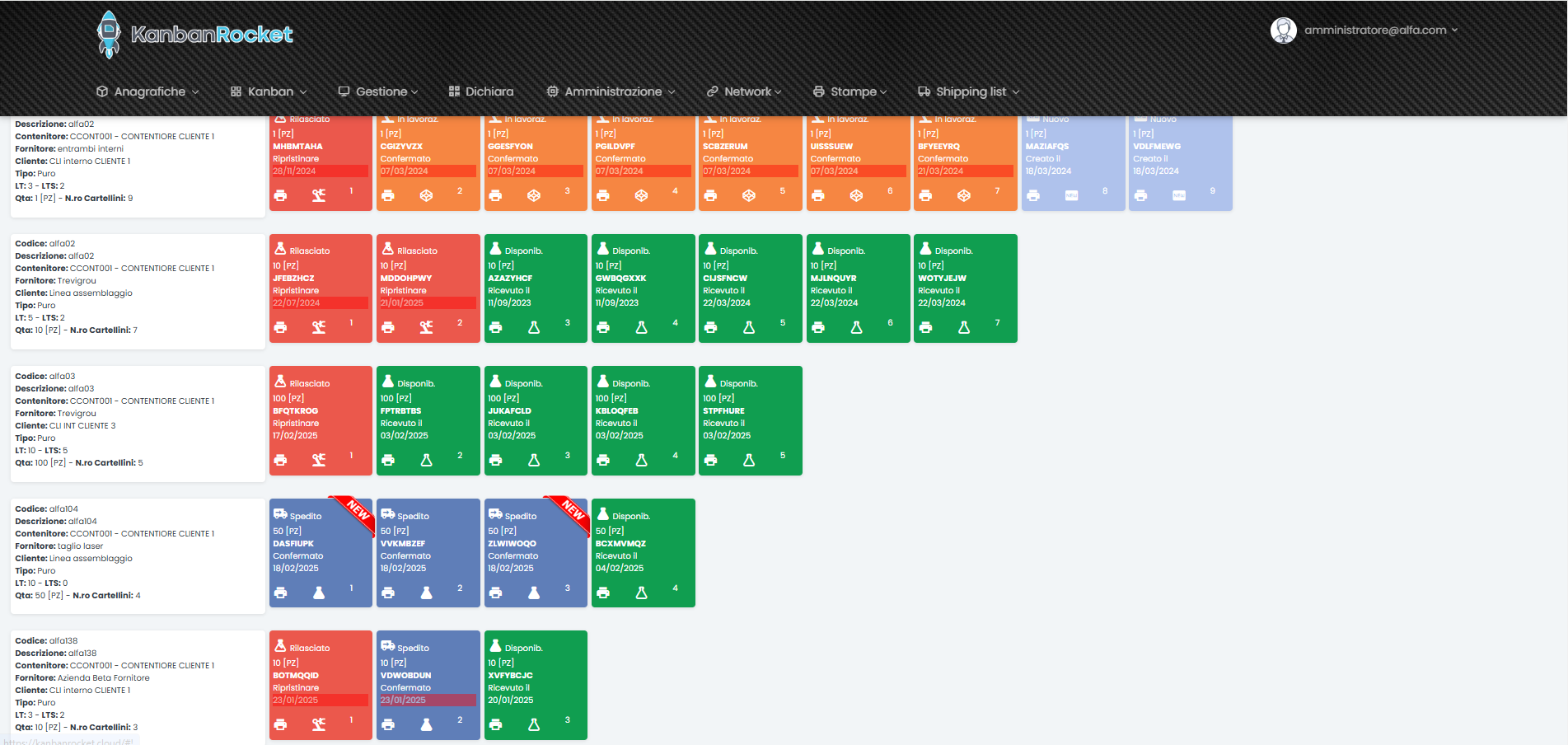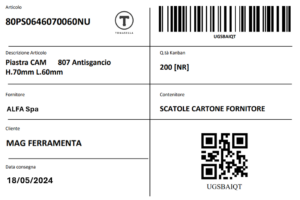
Kanban and Electronic Kanban for Logistics:
what it is, how it works, and when to apply it
Kanban is one of the most well-known tools of Lean Production, but it is often considered merely a “visual” or “manual” technique. In reality, if properly designed and digitalized (e-Kanban), it can radically transform the efficiency of logistics flows and supply chains, reducing inventory levels and operating costs.
In this article, we explore what Kanban is in the logistics and industrial context, how it works, its main benefits, and—above all—when it makes sense to apply it (and when it does not).
What is Kanban in the logistics–industrial context
Kanban for logistics is a material replenishment system based on the pull logic, where materials are restocked only after actual consumption.
The replenishment signal is represented by a card (physical or digital) that is triggered when a container is emptied. Each card contains key information such as:
- Item code and description
- Quantity per container
- External supplier or internal production center
- Lead time or expected delivery date (in the case of e-Kanban)
- Unique identifier (only for e-Kanban, e.g. barcode or QR code)

Two fundamental approaches
Physical Kanban (Toyota-style, 1970s)
- Requires a physical Kanban board to move cards.
- Cards are paper-based and often reusable/plasticized, or permanently attached to the container (which, when emptied, acts as the replenishment signal).
- An external system is needed for card printing (often Word, Excel, Access, etc. for formatting).
- An additional system is required for initial sizing and maintenance (often Excel).
- Tracking of card status is based on their position on the physical board (visibility limited to the company only, not shared with suppliers).
- High risk of errors: lost cards, missing data, delays—all managed manually.
Electronic Kanban — digital with KanbanRocket
- Cards exist both in physical format (attached to the container) and digital format, tracked through a unique identifier (barcode or QR code).
- Kanban cards (or Kanban labels) can be printed using a built-in print configurator within the platform.
- Initial sizing is a guided, error-proof process.
- Various modes of card maintenance exist, either automatic or semi-automatic: the system tracks and monitors consumption in real time and can generate resizing proposals.
- Each card is visible across the entire supply chain in real time, allowing suppliers and customers to detect potential issues before they become critical.
- The Kanban board is digital and shared between customer and supplier: eliminating emails, phone calls, and reminders.
- The system automatically generates documents such as purchase, production, or sales orders, as well as delivery notes (DDT), within the ERP (both customer and supplier side, if integrated).
- Automatic data collection: statistics, internal and external performance, traceability, etc.
How a typical e-Kanban workflow for material management works
- Material is withdrawn from a container by a picker or user.
- The card is released (physical and digital).
- The system automatically generates a replenishment request in the ERP (production, transfer, or purchase order).
- The supplier (internal or external) receives the signal and prepares the material.
- If required, the supplier prints the card and attaches it to the new container.
- The material is shipped, and the supplier updates the status (manually or automatically if integrated into their ERP).
- The Kanban container (with card attached) is delivered to the customer, who records goods receipt (physical and digital).
- The Kanban container is repositioned in the supermarket (inventory buffer), reintegrated into the flow, and the cycle restarts.
Types of Kanban
- Pure Kanban: each container has its own card. Replenishment starts when each unit is emptied. Ideal for high-consumption items.
- Signal Kanban: a single card is placed at the reorder point (ROP). Applicable only if the entire stock is stored in one location (e.g. stackable goods or tanks).
- Batch Kanban: replenishment starts only after a predefined number of empty units. Useful to meet minimum lot sizes required by suppliers (economic order or transport batches). Balances continuous downstream consumption with upstream lot constraints.
Types of Kanban flows
- Transfer Kanban: to move materials between departments or warehouses.
- Production Kanban: the supplier is an internal production center.
- Purchase Kanban: the supplier is external and manages replenishment.
- Sales Kanban: the company supplies its customers with pull logic.
Benefits of Kanban in logistics (Lean)
- Reduction of inventory: only what is needed, when it is needed.
- Elimination of overproduction.
- Increased inventory turnover.
- Manual workflow for simple, low-cost management.
Benefits of Digital Kanban (e-Kanban with KanbanRocket)
- Full traceability: each card has a unique ID and real-time status.
- Automatic planning: delivery dates calculated and displayed in supplier and customer calendars.
- Direct collaboration with suppliers/customers on the shared board.
- Data collection and KPIs: consumption variations, performance, anomalies.
- Zero risk of lost cards.
- Error-proof sizing wizard.
- Automatic card maintenance based on actual consumption.
- Digital workflow generates documents such as orders and delivery notes within the ERP, without waste.
- Direct integration with ERP, MES, WMS, BI, etc.
When to apply Kanban (and when not to)
Yes to Kanban when:
- Items have medium or high consumption frequency.
- Lead time is stable.
- The supplier (or customer) agrees to a pull logic.
- The goal is to avoid MRP/forecast-based planning.
No to Kanban when:
- Consumption is erratic or rare.
- Lead time is very long or unstable.
- Suppliers do not collaborate (e.g. do not respect lead times or quantities).
- The item is used only for occasional, make-to-order projects.
Recommendations before implementing Kanban
- Analyze positioning of decoupling points.
- Check lead time and consumption stability.
- Run ABC-RRS analysis (and others, such as HML or No-Moving).
- Properly design the sizing.
- Estimate impact on average inventory and turnover ratio.
- Perform backtesting simulations with real data.
👉 Watch our video (here is the link) where we explain step by step KanbanRocket Formula, our method to size and manage (automatically!) every stock item.
Kanban is a powerful tool—but not one to improvise.
If well designed and digitalized, it delivers measurable results:
- Lean and automated management of stock items.
- Average inventory under control.
- Elimination of urgencies and stockouts.
- Lead time monitoring.
- Real collaboration between customer and supplier.
KanbanRocket takes pull logic to the next level thanks to an integrated, automated, and shared platform. A true efficiency accelerator for every manufacturing company.
comments